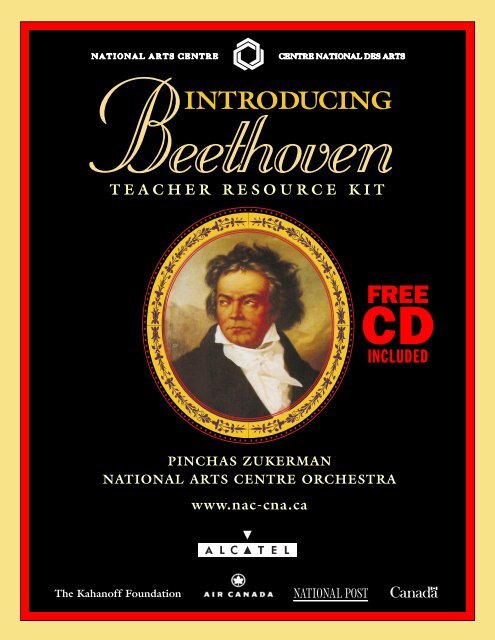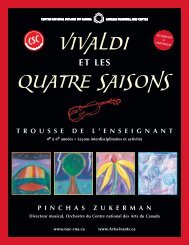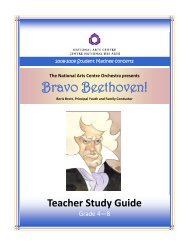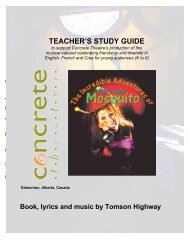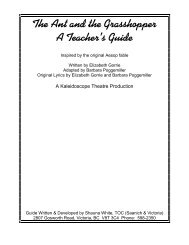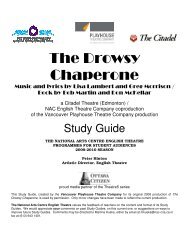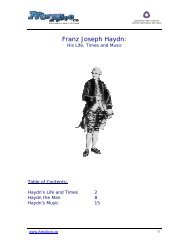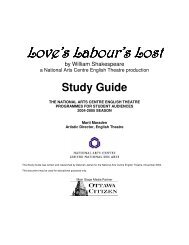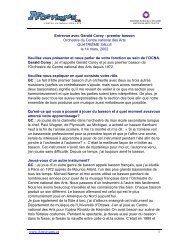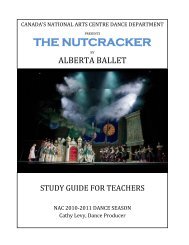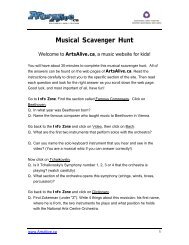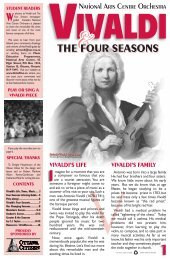Beethoven Teacher Resource kit - ArtsAlive.ca
Beethoven Teacher Resource kit - ArtsAlive.ca
Beethoven Teacher Resource kit - ArtsAlive.ca
Create successful ePaper yourself
Turn your PDF publications into a flip-book with our unique Google optimized e-Paper software.
TEACHER RESOURCE KIT<br />
PINCHAS ZUKERMAN<br />
NATIONAL ARTS CENTRE ORCHESTRA<br />
The Kahanoff Foundation<br />
www.nac-cna.<strong>ca</strong><br />
FREE<br />
CD<br />
INCLUDED
WTEACHER RESOURCE<br />
KIT<br />
elcome to the National Arts Centre’s <strong>Teacher</strong> <strong>Resource</strong> Kit on Ludwig<br />
van <strong>Beethoven</strong>. We hope that the information in this <strong>kit</strong>, and the related<br />
activities, will assist you in introducing young people to one of the world’s<br />
greatest composers.<br />
The <strong>kit</strong> has been distributed to elementary schools across Canada and is available<br />
to download free of charge from the NAC web site at www.nac-cna.<strong>ca</strong>.<br />
Included in the <strong>Beethoven</strong> <strong>Teacher</strong> <strong>Resource</strong> Kit are the following materials:<br />
c A teacher’s guide containing information on the life, times, and music of<br />
composer Ludwig van <strong>Beethoven</strong>; his contemporaries in music, art, and literature;<br />
artists and the challenges they face and overcome; the link between<br />
artists and human rights; the instruments of the orchestra; Pinchas Zukerman<br />
and the National Arts Centre; and edu<strong>ca</strong>tional outreach programmes of<br />
Canadian orchestras<br />
c Student activity sheets that complement the teacher’s guide and have been<br />
developed with an eye towards integrating music and the arts into the classroom<br />
study of history, social studies, and language arts<br />
c A complimentary CD recording of Pinchas Zukerman performing <strong>Beethoven</strong>’s<br />
Romance for Violin no. 2, and conducting Symphonies nos. 1 and 2, performed<br />
by the National Arts Centre Orchestra.<br />
The National Arts Centre would like to thank the following partners:<br />
Government of Canada<br />
Al<strong>ca</strong>tel Networks Corporation<br />
The Kahanoff Foundation<br />
Air Canada<br />
Department of Foreign Affairs and International Trade<br />
Department of Canadian Heritage<br />
National Post<br />
National Gallery of Canada<br />
<strong>Beethoven</strong>-Haus, Bonn<br />
German Embassy, Ottawa<br />
Ce document est disponible en français :<br />
veuillez appeler (613) 947-7000, poste 390 (www.nac-cna.<strong>ca</strong>).<br />
Introducing <strong>Beethoven</strong> 1
PHOTO: ETIENNE MORIN, LEDROIT<br />
PHOTO: FRED CATTROLL<br />
Peter Herrndorf<br />
Pinchas Zukerman<br />
A MESSAGE FROM . . .<br />
PeterHerrndorf<br />
The National Arts Centre is proud<br />
to partner with Tundra Books in producing<br />
this Introducing <strong>Beethoven</strong><br />
<strong>Teacher</strong> <strong>Resource</strong> Kit. We hope it will<br />
demonstrate to you, the reader, our<br />
commitment to the development of<br />
young minds through the teaching<br />
of the arts.<br />
This is the second of what we<br />
hope will be a series of study guides<br />
on the lives of the great composers.<br />
A resource <strong>kit</strong> on Antonio Vivaldi<br />
and the Four Seasons was produced<br />
in 1999, with an accompanying CD<br />
recording of the Four Seasons, performed<br />
by Pinchas Zukerman and the<br />
NAC Orchestra. This <strong>kit</strong> was distributed,<br />
free of charge, to four thousand<br />
elementary schools across Canada.<br />
We have expanded our distribution<br />
of the <strong>Beethoven</strong> Kit to reach every<br />
elementary school in Canada – over<br />
twelve thousand schools.<br />
The National Arts Centre belongs<br />
to all Canadians. Through our edu<strong>ca</strong>tional<br />
outreach efforts, we hope to<br />
make a difference in the lives of<br />
young people across the country.<br />
Sincerely,<br />
Peter Herrndorf<br />
Director & CEO<br />
National Arts Centre<br />
2 National Arts Centre: A World-Class Performing Arts Centre<br />
Pinchas Zukerman<br />
I am very excited to be sharing with<br />
all of you the music, life, and times<br />
of one of the greatest musi<strong>ca</strong>l masters,<br />
and one of my heroes, Ludwig van<br />
<strong>Beethoven</strong>.<br />
As a teacher myself, I am wholeheartedly<br />
committed to furthering<br />
the musi<strong>ca</strong>l experience for all young<br />
people. It is my hope that this<br />
<strong>Beethoven</strong> <strong>Resource</strong> Kit and CD<br />
recording will allow you to help<br />
your young students discover some<br />
of the beauty of <strong>Beethoven</strong>’s music<br />
that so many of us have come to<br />
enjoy as performers and as listeners.<br />
Sincerely,<br />
Pinchas Zukerman<br />
Music Director<br />
National Arts Centre Orchestra
Table of Contents<br />
Ludwig van <strong>Beethoven</strong><br />
<strong>Beethoven</strong>’s Life . . . . . . . . . . . . . . . . . . . . . . . . . . . . . . . . . . 4<br />
<strong>Beethoven</strong> the Musician . . . . . . . . . . . . . . . . . . . . . . . . . . . 6<br />
<strong>Beethoven</strong> and Romanticism . . . . . . . . . . . . . . . . . . . . . . . 8<br />
<strong>Beethoven</strong>’s Times . . . . . . . . . . . . . . . . . . . . . . . . . . . . . . . 10<br />
<strong>Beethoven</strong>’s Contemporaries . . . . . . . . . . . . . . . . . . . . . . 12<br />
Artists Who Have Faced Challenges . . . . . . . . . . . . . . . . 13<br />
Human Rights and the Arts . . . . . . . . . . . . . . . . . . . . . . . 14<br />
The Instruments of the Orchestra . . . . . . . . . . . . . . . . . . 16<br />
Pinchas Zukerman and the National Arts Centre Orchestra . . 18<br />
National Arts Centre . . . . . . . . . . . . . . . . . . . . . . . . . . . . . . . . . . . . 19<br />
Canadian Orchestras and Edu<strong>ca</strong>tion . . . . . . . . . . . . . . . . . . . . . . 20<br />
<strong>Resource</strong> Materials . . . . . . . . . . . . . . . . . . . . . . . . . . . . . . . . . . . . . . 21<br />
Student Activity Sheets . . . . . . . . . . . . . . . . . . . . . . . . . . . . . . . . . . 22<br />
Introducing <strong>Beethoven</strong> 3
Ludwig van<strong>Beethoven</strong>:<br />
A COMPOSER MADE OF FIRE<br />
<strong>Beethoven</strong>’ s Life<br />
L<br />
udwig van <strong>Beethoven</strong> was a complex, difficult man consumed by a towering<br />
genius – all the more remarkable for the deafness with which he<br />
struggled – who lived a life driven by an unquenchable need to make<br />
music. His legacy is music that still delights, challenges, and moves us.<br />
Born in Bonn, Germany on December 17, 1770 (or perhaps a day earlier<br />
according to some records), <strong>Beethoven</strong> had a miserable childhood. He was one<br />
of seven children, only three of whom survived to adulthood. Although he loved<br />
his gentle mother, Maria, he feared his hard-drinking, demanding father, Johann.<br />
Johann had no great talent, but he gave music lessons to the children of the<br />
nobility. From the time Ludwig was a small boy, turning the iron handle of window<br />
shutters to hear the musi<strong>ca</strong>l noise, the child had been absorbed by music.<br />
His father recognized the boy’s ability and nurtured it, possibly be<strong>ca</strong>use he saw<br />
it as a source of income.<br />
In 1787, when he was seventeen, <strong>Beethoven</strong> made his first trip to Vienna, the<br />
city that would become his home. There, he was quickly immersed in the life of<br />
Europe’s cultural <strong>ca</strong>pital, even playing the piano for Mozart. Mozart’s prediction<br />
was: “You will make a big noise in the world.”<br />
<strong>Beethoven</strong>’s stay was cut short by a series of family tragedies. He returned to<br />
Bonn to his dying mother. Shortly after, his infant sister died. When his father<br />
lost his job, <strong>Beethoven</strong> had to take responsibility for the family.<br />
After his father’s death in 1792, <strong>Beethoven</strong> returned to Vienna for<br />
good. The serious boy had grown into a man who was by turns rude<br />
and violent, kind and generous. He helped raise money for the only<br />
surviving child of Johann Sebastian Bach, who was living in poverty,<br />
and he donated new compositions for a benefit concert in aid of<br />
Ursuline nuns.<br />
Despite his temper, <strong>Beethoven</strong> attracted friends easily. He studied<br />
piano with composer Franz Joseph Haydn. And even though the student-teacher<br />
relationship failed, the two remained friends. In Vienna,<br />
<strong>Beethoven</strong> also met Mozart’s rival, Antonio Salieri – the man rumoured to have<br />
poisoned Mozart. Salieri was kind to <strong>Beethoven</strong> and, in return, <strong>Beethoven</strong> dedi<strong>ca</strong>ted<br />
three violin sonatas to him.<br />
With his talent and his larger-than-life personality, <strong>Beethoven</strong> was popular<br />
among women. Although he never married, he dedi<strong>ca</strong>ted such pieces as the<br />
Moonlight Sonata and Für Elise to the women in his life.<br />
4 National Arts Centre: A World-Class Performing Arts Centre
At the age of twenty-eight, just before writing his first symphony, <strong>Beethoven</strong><br />
began to lose his hearing. He tried every available treatment and, at first, there<br />
were periods when he could hear. But in the last de<strong>ca</strong>de of his life, he lost his hearing<br />
completely. Nevertheless, he continued to lead rehearsals and play the piano<br />
as late as 1814. Possibly he “heard” music by feeling its vibrations.<br />
As time passed, <strong>Beethoven</strong> be<strong>ca</strong>me more and more absorbed in his music. He<br />
began to ignore his grooming, pouring water over his head instead of washing in<br />
a basin. On one of his beloved country walks, he was arrested by<br />
a lo<strong>ca</strong>l policeman who assumed he was a tramp. His rooms<br />
were piled high with manuscripts that nobody was allowed to<br />
touch. He had four pianos without legs so that he could feel<br />
their vibrations. He often worked in his underwear, or even<br />
naked, ignoring the friends who <strong>ca</strong>me to visit him if they<br />
interrupted his composing.<br />
The stories about his temper be<strong>ca</strong>me legend: he threw hot<br />
food at a waiter; he swept <strong>ca</strong>ndles off a piano during a bad<br />
performance; he may even have hit a choirboy. His intensity<br />
spilled over into his family life. He be<strong>ca</strong>me embroiled in a bitter<br />
custody battle for a nephew who attempted suicide to<br />
es<strong>ca</strong>pe the family acrimony.<br />
Perhaps he was terrified and furious about losing the world<br />
of sound. Perhaps he was completely preoccupied by the need<br />
to create. Despite his behaviour, he was admired and respected for the music that<br />
poured from him. He knew that it moved his listeners to tears, but he responded:<br />
“Composers do not cry. Composers are made of fire.”<br />
In November 1826, <strong>Beethoven</strong> returned from his brother’s estate to Vienna in<br />
an open wagon. By the time he got home he was ill with pneumonia, from which<br />
he never fully recovered. Late in the afternoon of March 26, 1827, the sky<br />
be<strong>ca</strong>me dark. Suddenly <strong>Beethoven</strong>’s room was lit by a flash of lightning. A great<br />
clap of thunder followed. <strong>Beethoven</strong> opened his eyes, raised his fist, and fell back<br />
dead. He was fifty-seven years old.<br />
Ludwig van <strong>Beethoven</strong>’s funeral was the final demonstration of the esteem in<br />
which he was held. On March 29, 1827, twenty thousand people lined the<br />
streets, while soldiers controlled the grieving crowd. Nine priests blessed the<br />
composer’s body.<br />
He was buried in a grave marked by a simple pyramid on which was written<br />
one word: “<strong>Beethoven</strong>.” Today his remains lie beside those of the Austrian composer<br />
Franz Schubert, in Vienna’s Central Cemetery.<br />
The <strong>Beethoven</strong>-Haus<br />
(<strong>Beethoven</strong> House)<br />
The <strong>Beethoven</strong> family’s<br />
apartment on Bonngasse<br />
in Bonn, with its <strong>kit</strong>chen<br />
and three rooms, has been<br />
preserved. Visitors <strong>ca</strong>n see<br />
<strong>Beethoven</strong>’s piano, ear<br />
trumpet, manuscripts to<br />
some of his music, and<br />
the little room in which<br />
he was born.<br />
Introducing <strong>Beethoven</strong> 5
What is . . .<br />
A CONCERTO?<br />
A concerto is a musi<strong>ca</strong>l<br />
composition, usually in three<br />
movements, in which a solo<br />
instrument performs a<br />
solo part accompanied by a<br />
full orchestra.<br />
What is . . .<br />
A MOVEMENT?<br />
A movement is the largest,<br />
unified division of a musi<strong>ca</strong>l<br />
composition, separated by<br />
pauses.<br />
<strong>Beethoven</strong> the Musician<br />
V<br />
ienna was the heart of musi<strong>ca</strong>l Europe, and <strong>Beethoven</strong> easily took his<br />
place as both performer and composer. He lived for a time in the home of<br />
Prince Lichnowsky, an accomplished musician who studied and played<br />
<strong>Beethoven</strong>’s new piano sonatas and paid the cost of publishing his Opus 1.<br />
<strong>Beethoven</strong>’s first public appearance as a piano virtuoso took place when he<br />
was twenty-five years old. He was to play his Second Piano Concerto, but two<br />
days before the performance it was still not finished and <strong>Beethoven</strong> was suffering<br />
from an upset stomach. He continued to write while a friend fed him remedies<br />
and, just outside his chamber, copyists sat waiting for the music as the composer<br />
finished writing each sheet.<br />
His <strong>ca</strong>reer would be full of such last-minute scrambles. On the morning of the<br />
concert to present an oratorio, Christ on the Mount of Olives, a friend found<br />
<strong>Beethoven</strong> sitting in bed, composing the part for the trombones. The piece had<br />
its first rehearsal at 8:00 a.m., with the trombone players reading from the original<br />
sheets of music.<br />
6 National Arts Centre: A World-Class Performing Arts Centre<br />
Ludwig van <strong>Beethoven</strong>, miniature painted on ivory<br />
by Christian Horneman (1802)<br />
<strong>Beethoven</strong>-Haus Bonn, Collection H.C. Bodmer
Although <strong>Beethoven</strong> was primarily a pianist, he also composed for strings. In<br />
1797, he worked on Three Piano Sonatas, Opus 10. One year later, he composed<br />
the Piano Concerto no. 1; Three String Trios, Opus 9; and Three Violin Sonatas,<br />
Opus 12. By the time he was thirty years old in 1800, he had completed Six String<br />
Quartets, Opus 18 and the popular Septet, Opus 20. In 1806, he composed three<br />
pieces, Opus 59, for string quartet. They sounded so new and different that one<br />
man remarked, “Surely you do not consider these works to be music?” <strong>Beethoven</strong><br />
replied, “Oh, they are not for you, but for a later age.” He was right.<br />
Photo of <strong>Beethoven</strong>’s Piano, <strong>Beethoven</strong>-Haus Bonn, Collection H.C. Bodmer<br />
What is . . .<br />
A SONATA?<br />
A sonata is a piece of<br />
music, usually in three or<br />
four movements, for a<br />
solo instrument or a solo<br />
instrument accompanied<br />
by a piano – for example,<br />
a flute and piano.<br />
What is . . .<br />
A SYMPHONY?<br />
A symphony is a long, highly<br />
organized composition for<br />
full orchestra, usually in<br />
four movements.<br />
Introducing <strong>Beethoven</strong> 7
<strong>Beethoven</strong> and Romanticism<br />
When <strong>Beethoven</strong> was born in 1770, the ideal in society was Classicism. It<br />
was a disciplined and structured worldview, according to which the form<br />
of things was important. Value was given to poetry, literature, painting, and<br />
music that was restrained and rational. By the 1800s, Classicism was giving way to<br />
Romanticism, and <strong>Beethoven</strong>’s music led the change in Classi<strong>ca</strong>l music.<br />
Romanticism valued imagination and emotion over intellect and reason. It was<br />
based on a belief that people are naturally good, that physi<strong>ca</strong>l passion is splendid,<br />
and that politi<strong>ca</strong>l authority and rigid conventions should be overthrown.<br />
<strong>Beethoven</strong>’s Romanticism transformed every kind of music he composed.<br />
One of his most popular compositions is the Moonlight Sonata, the second of two<br />
sonatas making up Opus 27. It be<strong>ca</strong>me known as the Moonlight Sonata well after<br />
<strong>Beethoven</strong>’s death, when poet Ludwig Rellstab said that it reminded him of<br />
moonlight rippling on the waves of Lake Lucerne in Switzerland. Like all<br />
Romantic art, it appeals to the senses first.<br />
<strong>Beethoven</strong>’s Romance no.1 for Violin in G, Opus 40 and his Romance no. 2<br />
for Violin in F, Opus 50, written between 1798 and 1802, were <strong>ca</strong>lled romances<br />
for their light, sweet tone, almost like a song. This is typi<strong>ca</strong>l of the Romantic<br />
period in music: many pieces lend themselves to being sung as well as played.<br />
<strong>Beethoven</strong>’s movement away from Classicism and toward Romanticism is<br />
clearest in his symphonies. Before <strong>Beethoven</strong>, symphonies had conformed to the<br />
ideals of Classicism with clear structure and rational form. <strong>Beethoven</strong>’s Romantic<br />
symphonies broke out of those confines and be<strong>ca</strong>me large, sometimes epic structures<br />
that plumbed emotional depths.<br />
<strong>Beethoven</strong>’s first symphony was presented in 1800. Although the orchestra<br />
members were not sufficiently skilled to play the music, and the critics were<br />
unforgiving, it be<strong>ca</strong>me widely known if not always liked. In 1802, <strong>Beethoven</strong><br />
completed his Second Symphony, which has been described as “full of summer<br />
air and summer flowers.”<br />
<strong>Beethoven</strong> had intended to dedi<strong>ca</strong>te the Eroi<strong>ca</strong>, his third and possibly<br />
favourite symphony, to Napoleon be<strong>ca</strong>use he thought that Napoleon would free<br />
Europe from the iron-fisted control of royalty. In 1804, Napoleon proclaimed<br />
himself Emperor. <strong>Beethoven</strong> raged: “So, he is just like the rest, after all. He will<br />
become a greater tyrant than the others.” He grabbed the title page and<br />
scratched out the dedi<strong>ca</strong>tion so violently that he tore the paper.<br />
In 1804, <strong>Beethoven</strong> composed his only opera, Fidelio. It is interesting to listen<br />
for the musi<strong>ca</strong>l ideas that appear in the Third, the Fifth, and the Ninth<br />
Symphonies.<br />
8 National Arts Centre: A World-Class Performing Arts Centre
The Fifth Symphony, with its “da-da-da-daaa” beginning, is one of the<br />
world’s most famous pieces of music. <strong>Beethoven</strong> took these simple tones and<br />
rhythms and built the whole first movement around them. It has been suggested<br />
that these four notes represent the sound of Fate knocking at the door.<br />
The Sixth Symphony, the Pastoral, draws on <strong>Beethoven</strong>’s love of nature, which<br />
he depicts in a series of musi<strong>ca</strong>l scenes. Very different from Classi<strong>ca</strong>l structure,<br />
Pastoral is longer and more complex. By the Ninth Symphony, <strong>Beethoven</strong> had<br />
incorporated poetry, vo<strong>ca</strong>l soloists, and choir, as well as starkly contrasting moods.<br />
All these innovations paved the way for such Romantics as Schubert,<br />
Schumann, Mendelssohn, Brahms, Mahler, Wagner, and Strauss.<br />
Mercury and Argus, J.M.W. Turner, National Art Gallery of Canada, Ottawa, Purchased 1939<br />
Introducing <strong>Beethoven</strong> 9
<strong>Beethoven</strong>’ s Times<br />
B<br />
eethoven lived in a period of great turmoil. The French Revolution,<br />
which began on July 14, 1789, rocked Europe. The ideals of the French<br />
Revolution included equality and free speech for all. Within four years<br />
those fine ideals devolved into the Reign of Terror that overtook France and<br />
affected the rest of Europe. In 1798, Napoleon conquered Egypt, beginning his<br />
rise to power. Against the politi<strong>ca</strong>l upheaval, every aspect of human life seemed<br />
to shift. It was an age of change in ideas, the arts, science, and the structure of<br />
society itself.<br />
An age of the musician: Earlier in the 18 th century, the Church dominated the<br />
world of music. As time went on, the nobility began to enjoy music and even<br />
learned to play musi<strong>ca</strong>l instruments. Composers and musicians were their servants.<br />
With his fiercely independent spirit, <strong>Beethoven</strong> challenged this notion. “It<br />
is good to move among the aristocracy,” he said, “but it is first necessary to make<br />
them respect us.” When a nobleman talked while he was performing, <strong>Beethoven</strong><br />
stopped playing to declare: “For such pigs I do not play!”<br />
Literature and art also flourished during <strong>Beethoven</strong>’s lifetime. The first edition<br />
of the Encyclopedia Britanni<strong>ca</strong> appeared in three volumes.<br />
An age of exploration: In 1770, Captain James Cook circumnavigated the globe,<br />
charting the coast of New Zealand and eastern Australia as well as the Bering Strait.<br />
James Bruce traced the Blue Nile to its confluence with the White Nile in 1771.<br />
An age of invention: John Kay patented the fly shuttle in 1733, making it possible<br />
to weave wide cloth. James Hargreaves invented the spinning jenny in<br />
1765, which spun many threads at the same time. James Watt invented the steam<br />
engine, patented in 1769, and Robert Fulton initiated steamship travel. The first<br />
railroad in England began operation early in the eighteenth century.<br />
Metronome<br />
10 National Arts Centre: A World-Class Performing Arts Centre
<strong>Beethoven</strong> be<strong>ca</strong>me friends with Johann Nepomuk Mälzel, the “Court<br />
Mechanician.” He invented the musi<strong>ca</strong>l chronometer, which in time was refined<br />
to the metronome, a device that <strong>ca</strong>n be set to a specific pace to guide the musician.<br />
<strong>Beethoven</strong> loved the chronometer and even composed a little <strong>ca</strong>non to the<br />
words “Ta ta ta (suggesting the beat of the chronometer) lieber lieber Mälzel.”<br />
An age of science and mathematics: Joseph-Louis Lagrange formulated the<br />
metric system and explained the satellites of Jupiter and the phases of the moon.<br />
Benjamin Franklin conducted his experiments with electricity. Joseph Priestley<br />
discovered oxygen. Edward Jenner developed the smallpox vaccine. Musician<br />
and astronomer William Herschel discovered Uranus.<br />
An age of new pastimes: Coffee drinking – which <strong>Beethoven</strong> loved – be<strong>ca</strong>me a<br />
part of social life. Gambling, lotteries, <strong>ca</strong>rd-playing, chess, checkers, dominoes,<br />
and billiards all entertained people.<br />
Introducing <strong>Beethoven</strong> 11
I Wandered Lonely as a Cloud<br />
by William Wordsworth<br />
I wandered lonely as a cloud<br />
That floats on high o’er vales and hills,<br />
When all at once I saw a crowd,<br />
A host, of golden daffodils;<br />
Beside the lake, beneath the trees,<br />
Fluttering and dancing in the breeze.<br />
Continuous as the stars that shine<br />
And twinkle on the milky way,<br />
They stretched in never-ending line<br />
Along the margin of a bay;<br />
Ten thousand saw I at a glance,<br />
Tossing their heads in sprightly dance.<br />
The waves beside them danced; but they<br />
Outdid the sparkling waves in glee;<br />
A poet could not but be gay,<br />
In such a jocund company;<br />
I gazed – and gazed – but little thought<br />
What wealth the show to me had brought:<br />
For oft, when on my couch I lie<br />
In va<strong>ca</strong>nt or in pensive mood,<br />
They flash upon that inward eye<br />
Which is the bliss of solitude;<br />
And then my heart with pleasure fills,<br />
And dances with the daffodils.<br />
1804<br />
<strong>Beethoven</strong>’ s Contemporaries<br />
B<br />
eethoven was not the only composer writing music in this period. Richard<br />
Wagner’s (1813–1883) early instrumental works were influenced by<br />
<strong>Beethoven</strong>. Franz Liszt (1811–1886) “invented” the solo piano recital.<br />
Giuseppe Verdi (1813–1901) composed great operas. Frédéric Chopin<br />
(1810–1849) and Robert Schumann (1810–1856) also belonged to this era.<br />
British poet William Wordsworth (1770–1850), along with Samuel Taylor<br />
Coleridge (1772–1834), began the English Romantic movement in literature.<br />
Like <strong>Beethoven</strong> in music and Turner in painting, Wordsworth used nature as a<br />
theme in much of his writing.<br />
The shift from the Classic to the Romantic tradition was also reflected in the<br />
work of painters and sculptors such as the Spanish master Francisco José de Goya<br />
and Swiss-born Angeli<strong>ca</strong> Kauffmann, who produced more than five hundred<br />
paintings in her lifetime.<br />
The painter who most closely paralleled <strong>Beethoven</strong>’s move to Romanticism<br />
was Jean-Baptiste Camille Corot (1796–1875). Early in his <strong>ca</strong>reer he painted structured<br />
lands<strong>ca</strong>pes, but as he matured in works like Ville d’Avray and Memory of<br />
Mortefontaine, he showed a more imaginative style, creating a filmy aura.<br />
The Bridge at Narni, Camille Corot, National Art Gallery of Canada, Ottawa, Purchased 1939<br />
12 National Arts Centre: A World-Class Performing Arts Centre
ArtistsWhoHaveFaced Challenges<br />
W<br />
e are haunted by the idea of <strong>Beethoven</strong>, the composer of some of the<br />
most beautiful music the world has known, losing the sense that must<br />
have mattered the most to him – his hearing. He was not the only artist to<br />
have confronted, and risen to, such a challenge.<br />
Francisco José de Goya (1746–1828), one of the great Spanish masters,<br />
be<strong>ca</strong>me deaf in 1792 as the result of an illness. He continued to paint, but his<br />
work reflected his sadness.<br />
The great French Impressionist painter Claude Monet (1840–1926) found<br />
his eyesight failing him late in his life. He continued to paint, studying his subjects<br />
so closely that the paintings appeared fragmented like abstract art.<br />
Edgar Degas (1834–1917), another French artist, began to lose his eyesight<br />
when he was in his fifties. He began working in sculpture and in pastels, choosing<br />
subjects that did not require <strong>ca</strong>reful attention to detail.<br />
One of the finest artists to come out of Mexico was Frida Kahlo<br />
(1907–1954). She began painting in 1925 while recovering from a street<strong>ca</strong>r accident.<br />
Many of her paintings reflect the physi<strong>ca</strong>l pain she suffered.<br />
The Dutch painter Vincent van Gogh (1853–1890) suffered from seizures<br />
and depression. After quarrelling with fellow artist Paul Gauguin (1848–1903),<br />
he sliced off a piece of his ear lobe. Van Gogh committed suicide in 1890.<br />
Itzhak Perlman (1945–), the wonderful Israeli violinist, be<strong>ca</strong>me ill with polio<br />
at the age of four. As a result of the disease, Perlman performs and conducts from<br />
a seated position.<br />
Ear trumpet<br />
Introducing <strong>Beethoven</strong> 13
What is . . .<br />
THE UNITED<br />
NATIONS?<br />
The United Nations was<br />
established on October 24,<br />
1945 by 51 countries<br />
committed to preserving<br />
peace through international<br />
cooperation and collective<br />
security. Today, membership<br />
totals 188 countries.<br />
(Source: www.un.org)<br />
What is . . .<br />
UNESCO?<br />
The United Nations<br />
Edu<strong>ca</strong>tional, Scientific,<br />
and Cultural Organization<br />
(UNESCO) was established<br />
to contribute to peace and<br />
security in the world by<br />
promoting collaboration<br />
among nations through<br />
edu<strong>ca</strong>tion, science, culture,<br />
and communi<strong>ca</strong>tion in<br />
order to further universal<br />
respect for justice, for the<br />
rule of law, and for the<br />
human rights and fundamental<br />
freedoms, which are<br />
affirmed for the peoples of<br />
the world, without distinction<br />
of race, sex, language,<br />
or religion, by the Charter<br />
of the United Nations.<br />
(Source: www.unesco.org)<br />
HumanRights and theArts<br />
T<br />
hroughout history, artists have used their talents to comment on social<br />
issues. <strong>Beethoven</strong> – who lived through the French Revolution and the<br />
Napoleonic Wars, a time of immense social and politi<strong>ca</strong>l change in Europe<br />
and the world – responded through his music. His only opera, Fidelio, is set in<br />
Spain and is based on the story of a nobleman who is unjustly imprisoned for<br />
threatening to reveal the crimes of a politician.<br />
<strong>Beethoven</strong>’s third symphony, the Eroi<strong>ca</strong>, was originally dedi<strong>ca</strong>ted to Napoleon<br />
Bonaparte. The finale of his magnificent Ninth Symphony is based on a poem<br />
written by the German poet Friedrich von Schiller, with words and music that<br />
yearn for peace, joy, and the brotherhood of man.<br />
Like <strong>Beethoven</strong>, we have lived through enormous social and politi<strong>ca</strong>l<br />
upheaval: world conflicts, the rise and collapse of nations, and devastating politi<strong>ca</strong>l<br />
oppression around the world. We have also seen hopeful changes, such as the<br />
creation of the United Nations as the principal international organization committed<br />
to building peace and global security.<br />
In <strong>Beethoven</strong>’s time, as in ours, the arts have been a voice to rail against politi<strong>ca</strong>l<br />
oppression and to make us aware of the plight of those in the greatest need.<br />
All the world over, ordinary men, women, and children have been moved to<br />
action through music. “We Shall Overcome” and “Nkosi sikelel’ iAfrika” (God<br />
Bless Afri<strong>ca</strong>) are two songs that <strong>ca</strong>rried a tremendous amount of influence for<br />
Blacks in the US and in South Afri<strong>ca</strong> in their struggle against racism, inequality,<br />
and injustice in the last half of the 20 th century. And <strong>Beethoven</strong>’s Ninth Symphony<br />
rang out at the Tiananmen Square protest in 1989 and at the collapse of the<br />
Berlin Wall in 1990.<br />
Did you know?<br />
In 1997, the National Arts Centre held an art contest to commemorate the 50 th<br />
anniversary of the Universal Declaration of Human Rights. Young people were<br />
asked to draw an image based on the contest’s theme, “Human Rights through<br />
the Eyes of our Youth,” illustrating what they would do to help protect the rights<br />
of people around the world. Canada’s Department of Foreign Affairs and<br />
International Trade (DFAIT) will have toured an exhibition of 50 drawings out<br />
of the 700 submitted to more than eighteen countries around the world by the<br />
time the artwork returns to Ottawa in 2001! (You <strong>ca</strong>n view the gallery of drawings<br />
at: www.dfait-maeci.gc.<strong>ca</strong>.)<br />
14 National Arts Centre: A World-Class Performing Arts Centre
Did you know?<br />
Jazz sensation, pianist Os<strong>ca</strong>r Peterson, won the 2000 International Music<br />
Council/UNESCO Music Prize. This prize rewards musicians and musi<strong>ca</strong>l institutions<br />
whose work or activities have contributed to the enrichment of music and<br />
have served peace and understanding between peoples. He is the first Canadian<br />
to receive this prestigious international prize.<br />
What is . . .<br />
WAR CHILD?<br />
War Child is an international nongovernmental organization (NGO) that continues<br />
to use the enormous support it receives from the media and the music and<br />
entertainment industries to raise much-needed funds and public awareness of the<br />
daily struggle facing children in war zones. Luciano Pavarotti regularly raises<br />
money for War Child through benefit concerts that bring together many of<br />
today’s best-known musicians<br />
Who is . . .<br />
LESTER B. PEARSON?<br />
Lester Bowles Pearson was<br />
a prime minister of Canada.<br />
He received the Nobel<br />
Peace Prize in 1957, when<br />
he was Minister of External<br />
Affairs, for putting into<br />
place an international<br />
peacekeeping force led by<br />
Canadian troops to <strong>ca</strong>lm<br />
the hostilities surrounding<br />
the Suez Crisis between<br />
Britain, France, and Egypt.<br />
What is . . .<br />
THE INTERNATIONAL<br />
LANDMINES TREATY?<br />
Canada took a lead in 1997<br />
in the creation of an international<br />
treaty that would<br />
ban the production, trade,<br />
stockpiling, and use of<br />
antipersonnel landmines.<br />
The treaty was signed in<br />
1997 by 122 countries.<br />
Since then, another 15<br />
countries have signed on.<br />
(Source: www.icbl.org)<br />
Introducing <strong>Beethoven</strong> 15
TheInstruments of the Orchestra<br />
O<br />
rchestras are made up of a variety of instruments in four different <strong>ca</strong>tegories:<br />
strings, woodwinds, brass, and percussion. Here are some important<br />
characteristics of the instruments in each <strong>ca</strong>tegory:<br />
Strings<br />
violins, violas, cellos, and double basses<br />
c All string instruments have four strings;<br />
c The vibration of the strings produces the sound;<br />
c A string player either draws a bow made of horsehair across the<br />
strings, or plucks the strings with his or her fingers to produce<br />
sound;<br />
c The larger the instrument, the lower the sound – violins make the<br />
highest sounds and double basses the lowest;<br />
c Every string instrument is constructed of pieces of wood <strong>ca</strong>refully<br />
glued together and covered with several coats of varnish – no nails<br />
or screws are used.<br />
Woodwinds<br />
flutes, oboes, clarinets, and bassoons<br />
c Woodwind instruments are basi<strong>ca</strong>lly just tubes pierced with holes. The musician<br />
blows through the tube while covering some holes to produce different notes;<br />
c Many wind instruments are played with reeds. A reed is a thin piece of <strong>ca</strong>ne that is set<br />
in motion as the musician blows across it. The oboe and bassoon use a double reed<br />
while the clarinet uses a single reed;<br />
c Most of the wind instruments are made from wood, like ebony, except for the flute,<br />
which is almost always made of silver;<br />
c Flutes create the highest notes, bassoons the lowest.<br />
16 National Arts Centre: A World-Class Performing Arts Centre
Brass<br />
trumpets, French horns,<br />
trombones, and tubas<br />
c Brass instruments produce the most resounding tones of all the instruments in the<br />
orchestra;<br />
c They are constructed from metallic loops of tubing in different lengths, with a<br />
mouthpiece at one end and a bell shape at the other;<br />
c The vibration of the musician’s lips produces the sound as air is blown in the mouthpiece;<br />
c Brass instruments have valves that the players press and release in order to change and<br />
produce different notes;<br />
c Trumpet, trombone, and tuba players use a mute that is held over the bell to soften<br />
the tone – French horn players <strong>ca</strong>n do the same thing using their hand.<br />
Percussion<br />
timpani<br />
c Percussion instruments are made of naturally resonant<br />
materials like skin, wood, and metal;<br />
c Sound is produced when the instrument is struck;<br />
c The percussion provides rhythm and character to the<br />
orchestra;<br />
c Different pitches are produced on the timpani by changing<br />
the skin tension either by tightening or loosening screws fixed<br />
to the shell, or by using the pedal.<br />
Introducing <strong>Beethoven</strong> 17
Pinchas Zukerman<br />
AND THE NATIONAL ARTS CENTRE ORCHESTRA<br />
Photo: National Arts Centre<br />
P<br />
inchas Zukerman is one of today’s most famous and well-respected musicians.<br />
He is a virtuoso of the violin and the viola, and is a conductor as well as a teacher.<br />
Maestro Zukerman:Vital Statistics<br />
c born in Tel Aviv, Israel, in 1948<br />
c began learning music with his father, first playing the recorder, then the clarinet and<br />
later, the violin<br />
c left his home and family in Tel Aviv when he was fourteen and moved to New York City<br />
to attend one of the most prestigious music schools in North Ameri<strong>ca</strong>, the Juilliard School<br />
c had a number of legendary mentors, including Isaac Stern, Pablo Casals, and Ivan<br />
Galamian<br />
c conducted some of the world’s finest orchestras, including those of Chi<strong>ca</strong>go, Israel,<br />
Berlin, and Montreal<br />
c debuted with the National Arts Centre Orchestra as a soloist and conductor in 1976<br />
c toured with the National Arts Centre Orchestra to Europe in 1990<br />
c made his debut as the National Arts Centre Orchestra’s music director in July 1999<br />
c founded, in July 1999, the NAC Young Artists Programme, which doubled its enrollment<br />
in 2000<br />
c is a pioneer in the use of videoconferencing technology, allowing him to teach music<br />
to students around the world without their having to leave home and family as he did<br />
c introduced a new acoustic system for the NAC concert hall, which greatly enhances the<br />
quality of sound without amplifi<strong>ca</strong>tion.<br />
The NAC Orchestra is classi<strong>ca</strong>l sized, which makes it about half the size of orchestras<br />
in Vancouver, Toronto, and Montreal. The Orchestra specializes in the music<br />
of the Classi<strong>ca</strong>l period, in particular the music of Haydn, Mozart, and <strong>Beethoven</strong>.<br />
Orchestra:Vital Statistics<br />
c 46 musicians<br />
c over 100 performances per year<br />
c 39 recordings made<br />
c over 50 pieces commissioned from Canadian composers<br />
c 32 Canadian cities visited on their 1991–92 cross-country tour to celebrate Canada’s<br />
125th anniversary<br />
c 10 cities visited on their 1999 Canadian tour<br />
c 4 tours of Europe since 1973<br />
c 11 appearances at the legendary Carnegie Hall in New York City<br />
c 32 years in existence.<br />
18 National Arts Centre: A World-Class Performing Arts Centre
National Arts Centre:<br />
A WORLD-CLASS PERFORMING ARTS CENTRE<br />
A Brief History<br />
In the early 1960s, Prime Minister Lester B. Pearson recognized the need and<br />
desire for Canadians from all walks of life to be able to show<strong>ca</strong>se excellence in<br />
Canadian performance arts – music, English and French theatre, dance, and variety.<br />
This recognition led to the passing of the National Arts Centre Act 1966–67,<br />
which in turn created the place we now <strong>ca</strong>ll the National Arts Centre. The NAC<br />
opened its doors on June 2, 1969, and was a gift to all Canadians in celebration<br />
of the country’s 100 th birthday. It is lo<strong>ca</strong>ted in Ottawa, along with other cultural<br />
institutions such as the National Gallery of Canada, the National Library, the<br />
National Archives, and the National Museums.<br />
The :Vital Statistics<br />
c presents more than 600 performances annually to almost half a million people<br />
c has three performing halls: Southam Hall (2,326 seats), Theatre (967 seats), and<br />
Studio (300 seats)<br />
c emphasizes programming for young people with the Family Theatre Series in English<br />
Theatre, the Young People’s Concert Series and Student Matinee Concert Series in<br />
Music, the Petits-Trots and Grands-Galops Series in French Theatre, and matinee<br />
performances of ballets including The Nutcracker in Dance<br />
c features the NACOtron at every Young People’s Concert, which uses four television<br />
<strong>ca</strong>meras strategi<strong>ca</strong>lly placed on stage to project images of the musicians onto a giant<br />
screen at the back of the stage<br />
c houses a unique permanent collection of Canadian and international art.<br />
Photo: Fred Cattroll<br />
Photo: Malak<br />
Introducing <strong>Beethoven</strong> 19
CanadianOrchestras<br />
AND EDUCATION<br />
M<br />
any orchestras in Canada offer programmes for young listeners and<br />
young performers. Is there an orchestra, in your area? Ask about its<br />
programmes. For a listing of Canadian orchestras, and web links to orchestra<br />
web sites, check out the Orchestras Canada web site at www.oc.<strong>ca</strong>.<br />
Below is a sampling of the types of programmes offered by Canadian orchestras<br />
for young audiences:<br />
1. Programmes and events:<br />
c student concerts<br />
c family concerts<br />
c open rehearsals<br />
c student ticket price for regular orchestra concerts<br />
2. School and orchestra partnered programmes:<br />
c composition projects<br />
c sectional rehearsals with student players<br />
c dispersal of information about the work of orchestra musicians and composers<br />
c discussion of relationship of music to other subject areas.<br />
3. Opportunities for advanced players:<br />
c apprenticeships<br />
c master classes<br />
c scholarships<br />
4. Special opportunities for student musicians, school and community choirs, and<br />
ensembles to play with the orchestra as part of an orchestral concert.<br />
Photo: National Arts Centre Photo: National Arts Centre<br />
20 National Arts Centre: A World-Class Performing Arts Centre
<strong>Resource</strong> Materials<br />
For <strong>Teacher</strong>s<br />
Blume, Friedrich. Classic and Romantic Music: A Comprehensive Survey. Trans. M. D.<br />
Herter Norton, New York: W. W. Norton & Company, 1970.<br />
Carlin, Richard. The World of Music: European Classi<strong>ca</strong>l Music: 1600–1825. New York:<br />
Facts on File, 1988.<br />
Grout, Donald Jay. A History of Western Music. New York: W. W. Norton & Company,<br />
1973.<br />
Hays, William, ed., Twentieth Century Views of Music History. New York: Charles<br />
Scribner & Sons, 1972.<br />
Fleming, William. Arts & Ideas. New York: Holt, Rinehart and Winston, 1986.<br />
Machlis, Joseph. The Enjoyment of Music: An Introduction to Perceptive Listening. New<br />
York: W. W. Norton & Company, 1955.<br />
Marek, George R. <strong>Beethoven</strong>: Biography of a Genius. New York: Funk & Wagnalls, 1969.<br />
Rosen, Charles. The Classi<strong>ca</strong>l Style: Haydn, Mozart, <strong>Beethoven</strong>. New York: W. W. Norton<br />
& Company, 1972.<br />
For Students<br />
Barber, David W., illustrations by Dave Donald. Bach, <strong>Beethoven</strong> and the Boys: Music<br />
History as it Ought to be Taught. Toronto: Sound and Vision Ltd., 1996.<br />
Bergamini, Andrea. Masters of Music: <strong>Beethoven</strong> and the Classi<strong>ca</strong>l Age. Hauppauge:<br />
Barron’s, 1999.<br />
Krull, Kathleen, illustrations by Kathryn Hewitt. Lives of the Musicians: Good Times, Bad<br />
Times (And What the Neighbors Thought). New York: Harcourt Brace & Company, 1993.<br />
Nichol, Barbara, illustrations by Scott Cameron. <strong>Beethoven</strong> Lives Upstairs. Toronto:<br />
Lester Books, 1993. (also on compact disc or audiotape)<br />
Rachlin, Ann, illustrations by Susan Hellard. <strong>Beethoven</strong> (Famous Children Series).<br />
Hauppauge: Barron’s, 1994.<br />
Learn More on theWeb<br />
www.nac-cna.<strong>ca</strong><br />
www.gprep.org/classi<strong>ca</strong>l/<br />
www.ffaire.com/beethoven/beethinstr.html<br />
www.en<strong>ca</strong>rta.msn.com<br />
home.swipnet.se/zabonk/cultur/ludwig/index.htm<br />
austria-tourism.at/famouspeople<br />
www.hearts-ease.org/conservatory/classi<strong>ca</strong>l/beethoven/index.html<br />
www.issay.com/bonn-beethoven-house<br />
CREDITS<br />
English text: E. Joan Abeles<br />
O’Callaghan<br />
Translation: Alain Cormier<br />
Edu<strong>ca</strong>tion editors: Claire Speed,<br />
Joanne Steadman<br />
Illustration: Bill Slavin<br />
Design: Ingrid Paulson<br />
Published by Tundra Books<br />
Introducing <strong>Beethoven</strong> 21
A <strong>Beethoven</strong>Autobiography<br />
What is the difference between a biography and an autobiography?<br />
Biography<br />
Autobiography<br />
Which do you think would be more informative?<br />
Why?<br />
List five important events in <strong>Beethoven</strong>’s life:<br />
1<br />
2<br />
3<br />
4<br />
5<br />
Now write <strong>Beethoven</strong>’s autobiography, imagining that you are <strong>Beethoven</strong> himself.<br />
Use an extra piece of paper if you need more space.<br />
22 National Arts Centre: A World-Class Performing Arts Centre
An Acrostic Poem<br />
Create an acrostic poem about <strong>Beethoven</strong>. Here’s how it’s done: You will see<br />
that <strong>Beethoven</strong>’s name has been written verti<strong>ca</strong>lly. Next to each letter of his name<br />
is a space. In each space, write a word that you think describes <strong>Beethoven</strong> and<br />
starts with that letter of the alphabet. The first one has been done for you. When<br />
you are finished, post your acrostic poem on the classroom bulletin board.<br />
B rave<br />
E<br />
E<br />
T<br />
H<br />
O<br />
V<br />
E<br />
N<br />
A <strong>Beethoven</strong> Cinquain<br />
A cinquain is a five line poem. Write your own cinquain about <strong>Beethoven</strong> by following<br />
the format given.<br />
First line – subject’s name (<strong>Beethoven</strong>)<br />
Second line – two adjectives or descriptive words<br />
Third line – three verbs<br />
Fourth line – a simile (like a . . . or, as a . . .)<br />
Fifth Line – a synonym for the first line<br />
<strong>Beethoven</strong><br />
Introducing <strong>Beethoven</strong> 23
A Post<strong>ca</strong>rd from<strong>Beethoven</strong><br />
In 1787, <strong>Beethoven</strong> made his first visit to Vienna. He didn’t stay very long, but<br />
it is said that he met Mozart on that oc<strong>ca</strong>sion. Create a post<strong>ca</strong>rd that <strong>Beethoven</strong><br />
might have sent to his family from Vienna. You may want to read a little about<br />
Vienna to learn about the attractions there before you start.<br />
In the top square, draw the picture that would appear on one side of the post<strong>ca</strong>rd.<br />
In the second square, compose the note that <strong>Beethoven</strong> would have written.<br />
24 National Arts Centre: A World-Class Performing Arts Centre
The Age of Discoveries<br />
The time period when <strong>Beethoven</strong> was born was one of many new discoveries and<br />
developments. For each of the names listed, fill in who the person was and why<br />
the discovery or invention is important.<br />
1. Joseph-Louis Lagrange<br />
The metric system<br />
2. James Watt<br />
The steam engine<br />
3. Edward Jenner<br />
Smallpox vaccine<br />
4. Captain James Cook<br />
The Bering Strait<br />
or<br />
The Hawaiian Islands<br />
5. Benjamin Franklin<br />
Electricity<br />
6. James Hargreaves<br />
The spinning jenny<br />
7. William Herschel<br />
Uranus<br />
Introducing <strong>Beethoven</strong> 25
A Romantic Collage<br />
<strong>Beethoven</strong>’s work represents a transition from the Classi<strong>ca</strong>l tradition in music to<br />
the Romantic. The Romantic style has many characteristics, including the expression<br />
of one’s emotions and a love of nature. Can you think of others?<br />
Using the space provided (or you may wish to use a larger separate backing),<br />
create a collage on the theme of Romanticism. Be prepared to present and<br />
explain your collage to your classmates.<br />
26 National Arts Centre: A World-Class Performing Arts Centre
A <strong>Beethoven</strong> Museum<br />
The <strong>Beethoven</strong> House, on Bonngasse in Bonn, is also the house in which<br />
<strong>Beethoven</strong> was born. In the museum are a number of artifacts. In a museum,<br />
there is usually a little <strong>ca</strong>rd telling the visitor what each item is and giving some<br />
information about it. For each of the artifacts listed below, write what you think<br />
should be on the <strong>ca</strong>rd in the space provided. You may add an artifact that you<br />
think should be in the museum.<br />
c<strong>Beethoven</strong>’s piano c<br />
c<strong>Beethoven</strong>’ s ear trumpet c<br />
cPastoral Symphony manuscript c<br />
Introducing <strong>Beethoven</strong> 27
Orchestra<br />
The NAC Orchestra, led by Pinchas Zukerman, is going on tour! Design a<br />
brochure to promote the Orchestra and its concerts. Use this page to help plan<br />
your brochure, then create it and display it in the classroom.<br />
Text<br />
Illustration<br />
The concert programme<br />
Some notes about <strong>Beethoven</strong><br />
Some notes about the NAC<br />
Illustration<br />
COVER PAGE<br />
INSIDE<br />
28 National Arts Centre: A World-Class Performing Arts Centre
Things toDo<br />
1. Create a time line of the important events in <strong>Beethoven</strong>’s life.<br />
2. Research the <strong>ca</strong>reer of Napoleon and, on a map of Europe, show the various<br />
countries he conquered, or tried to conquer.<br />
3. Listen to a recording of <strong>Beethoven</strong>’s music and explain to your classmates what<br />
is typi<strong>ca</strong>lly “<strong>Beethoven</strong>” about it.<br />
4. Write an obituary for <strong>Beethoven</strong>.<br />
5. If you had an opportunity to interview <strong>Beethoven</strong>, list five questions you<br />
would ask.<br />
6. Listen to a piece of music from the Romantic era (not necessarily by<br />
<strong>Beethoven</strong>) and paint an abstract picture in watercolours while listening to the<br />
music. How has the music influenced your painting?<br />
7. Choose an event in <strong>Beethoven</strong>’s life and create a journal entry for it. Try to<br />
understand how <strong>Beethoven</strong> might have felt.<br />
8. Choose an event from <strong>Beethoven</strong>’s life and, with a small group of your classmates,<br />
create a tableau to illustrate it. Explain your tableau to the rest of the<br />
class.<br />
9. Imagine you and two other classmates are making a movie about <strong>Beethoven</strong>’s<br />
life. Pick an incident and write a scene that you will perform for your class.<br />
10. Using a tape recorder and any sound effects you like, create a commercial to<br />
promote the NAC Orchestra. Play your commercial for your classmates.<br />
11. Design a poster to promote the NAC Orchestra concerts. Display your poster<br />
in the classroom.<br />
12. Design a poster to promote the <strong>Beethoven</strong> House in Bonn.<br />
13. Listen to the audiotape or CD of <strong>Beethoven</strong> Lives Upstairs and write a review<br />
of it.<br />
14. Read one of the books in the <strong>Resource</strong> Materials section of this publi<strong>ca</strong>tion.<br />
Explain to one of your classmates why he or she should also read it – or not.<br />
15. Create an advertisement to sell one of <strong>Beethoven</strong>’s pianos. Remember that<br />
they often did not have legs, that he pounded hard on the keys, and often<br />
spilled ink inside.<br />
16. Choose another artist (visual artist, composer, author) who was a contemporary<br />
of <strong>Beethoven</strong>’s. Research his or her life and give a report to your class.<br />
17. Write about some aspect of <strong>Beethoven</strong>’s life from the point of view of his<br />
piano.<br />
18. Create a poster advertising a concert featuring Mälzel’s musi<strong>ca</strong>l chronometer.<br />
19. Working with a small group of your classmates, compose a piece of music using<br />
only the most primitive of instruments: noises created by your voice, your<br />
hands, or your feet. Perform the piece for your class.<br />
20. Organize an opportunity, along with your teacher or parents, for you and your<br />
classmates to attend a performance by a symphony orchestra.<br />
Introducing <strong>Beethoven</strong> 29
<strong>Beethoven</strong>’s NinthSymphony<br />
B<br />
eethoven’s final symphony, the Ninth, is one of the most glorious pieces<br />
of music ever written. He began work on the Ninth Symphony in 1818<br />
and developed it over a six-year period. The Symphony sets the German<br />
poet Friedrich von Schiller’s beautiful Ode to Joy to music. The Symphony swells<br />
to a magnificent finale with orchestra, soloists, and chorus celebrating together<br />
in a delirious rapture.<br />
By the time the Ninth Symphony premiered in Vienna in 1824, <strong>Beethoven</strong><br />
was almost completely deaf. Nevertheless, he insisted on conducting the orchestra<br />
himself. He continued conducting even when the piece had ended be<strong>ca</strong>use he<br />
could not hear that the orchestra had stopped playing. One of the sopranos<br />
tugged at his sleeve so that he would turn around to face the audience – an audience<br />
wild with applause.<br />
<strong>Beethoven</strong>’s Ninth Symphony continues to move the hearts of people everywhere.<br />
It was played during the Beijing student protests in China in 1989 and at<br />
the dismantling of Germany’s Berlin Wall in 1990. It has become a symbol of<br />
unity, of love, and of the overwhelming power of music to change those who<br />
hear it forever.<br />
Play or Sing<strong>Beethoven</strong>!<br />
On the following pages you will find the words and music to the familiar melody<br />
found in the finale of <strong>Beethoven</strong>’s Ninth Symphony. Sing, or play along on a<br />
recorder, flute, or any other instrument.<br />
30 National Arts Centre: A World-Class Performing Arts Centre
In 1907, Henry Jackson van Dyke wrote the words to Joyful, Joyful We Adore<br />
Thee to the familiar tune found in <strong>Beethoven</strong>’s Ninth Symphony. It was first published<br />
in the Presbyterian Hymnal in 1911.<br />
Joyful, Joyful, We Adore Thee<br />
Joyful, joyful, we adore Thee, God of glory, Lord of love<br />
Hearts unfold like flowers before Thee, opening to the sun above.<br />
Melt the clouds of sin and sadness; drive the dark of doubt away;<br />
Giver of immortal gladness, fill us with the light of day!<br />
All Thy works with joy surround Thee, earth and heaven reflect Thy rays,<br />
Stars and angels sing around Thee, center of unbroken praise.<br />
Field and forest, vale and mountain, flowery meadow, flashing sea,<br />
Singing bird and flowing fountain <strong>ca</strong>ll us to rejoice in Thee.<br />
Thou art giving and forgiving, ever blessing, ever blessed,<br />
Wellspring of the joy of living, ocean depth of happy rest!<br />
Thou our Father, Christ our Brother, all who live in love are Thine;<br />
Teach us how to love each other, lift us to the joy divine.<br />
Mortals, join the happy chorus, which the morning stars began;<br />
Father love is reigning o’er us, brother love binds man to man.<br />
Ever singing, march we onward, victors in the midst of strife,<br />
Joyful music leads us Sunward in the triumph song of life.<br />
Introducing <strong>Beethoven</strong> 31
Symphony No. 9 Op. 125<br />
Finale<br />
“Ode to Joy”<br />
32 National Arts Centre: A World-Class Performing Arts Centre
• the music, life, and times of <strong>Beethoven</strong><br />
• activity sheets<br />
• music to sing or play<br />
• links to social studies and language arts<br />
WHAT TEACHERS ARE SAYING ABOUT THE NAC’S FIRST<br />
TEACHER RESOURCE KIT, VIVALDI FOUR SEASONS:<br />
Thank you for this beautiful resource <strong>kit</strong>. I work as a music teacher<br />
in an inner city school. Many of my students never listen to classi<strong>ca</strong>l music.<br />
They “love” Vivaldi . . . we dance to the music. They ask for more.<br />
– <strong>Teacher</strong>, Dartmouth, Nova Scotia<br />
Visit us on line at www.nac-cna.<strong>ca</strong><br />
• news and information about the National Arts Centre<br />
• downloadable copies of theVivaldi Four Seasons and Introducing<br />
<strong>Beethoven</strong> <strong>Teacher</strong> <strong>Resource</strong> Kits<br />
• and more<br />
Cover illustration: Ludwig van <strong>Beethoven</strong>, oil painting by Ferdinand Schimon<br />
(1818/19), <strong>Beethoven</strong>-Haus, Bonn<br />
Tundra Books<br />
TEACHER RESOURCE KIT<br />
ISBN 0-88776-541-6


